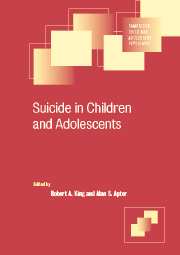Book contents
- Frontmatter
- Contents
- List of contributors
- Preface
- 1 The epidemiology of youth suicide
- 2 Suicide and the “continuum of adolescent self-destructiveness”: is there a connection?
- 3 Adolescent attempted suicide
- 4 Familial factors in adolescent suicidal behavior
- 5 Biological factors influencing suicidal behavior in adolescents
- 6 Psychodynamic approaches to youth suicide
- 7 Cross-cultural variation in child and adolescent suicide
- 8 An idiographic approach to understanding suicide in the young
- 9 Assessing suicidal behavior in children and adolescents
- 10 Suicide prevention for adolescents
- 11 Cognitive behavioral therapy after deliberate self-harm in adolescence
- 12 Follow-up studies of child and adolescent suicide attempters
- 13 Children and adolescents bereaved by a suicidal death: implications for psychosocial outcomes and interventions
- Index
Preface
Published online by Cambridge University Press: 04 December 2009
- Frontmatter
- Contents
- List of contributors
- Preface
- 1 The epidemiology of youth suicide
- 2 Suicide and the “continuum of adolescent self-destructiveness”: is there a connection?
- 3 Adolescent attempted suicide
- 4 Familial factors in adolescent suicidal behavior
- 5 Biological factors influencing suicidal behavior in adolescents
- 6 Psychodynamic approaches to youth suicide
- 7 Cross-cultural variation in child and adolescent suicide
- 8 An idiographic approach to understanding suicide in the young
- 9 Assessing suicidal behavior in children and adolescents
- 10 Suicide prevention for adolescents
- 11 Cognitive behavioral therapy after deliberate self-harm in adolescence
- 12 Follow-up studies of child and adolescent suicide attempters
- 13 Children and adolescents bereaved by a suicidal death: implications for psychosocial outcomes and interventions
- Index
Summary
In an epoch when rates of death and illness among the young have steadily decreased in the face of medical progress, the persistently high rates of youth suicide and suicide attempts in the West remain a tragic irony and a challenge to both our clinical practice and theoretical understanding. The purpose of this monograph is to present the current state of scientific and clinical knowledge regarding suicidal behavior in children and adolescents.
Clinical epidemiology now makes it possible to examine rates of completed suicide, as well as rates of suicidal ideation and attempts of varying degrees of severity in defined community populations of adolescents and children. Beyond prevalence rates, these studies provide important data on the demographic and psychosocial correlates of suicidal behavior, uncontaminated by the selection biases inherent in clinical samples. Despite the innate limitations posed by the unavailability of the key informant, modern postmortem psychological autopsy techniques also now give us systematic information concerning psychopathology and other risk factors in young suicides.
Although no single factor explains youth suicide, progress has been made in beginning to tease apart the tangle of intersecting domains of vulnerabilities that are associated with suicidal behavior in the young. Suicide is the most dramatic of the spectrum of self-destructive and health-endangering behaviors that unfortunately characterize adolescence. One of the editors' goals is to examine youth suicidal behavior in the context of this spectrum.
- Type
- Chapter
- Information
- Suicide in Children and Adolescents , pp. xiii - xivPublisher: Cambridge University PressPrint publication year: 2003
- 1
- Cited by

